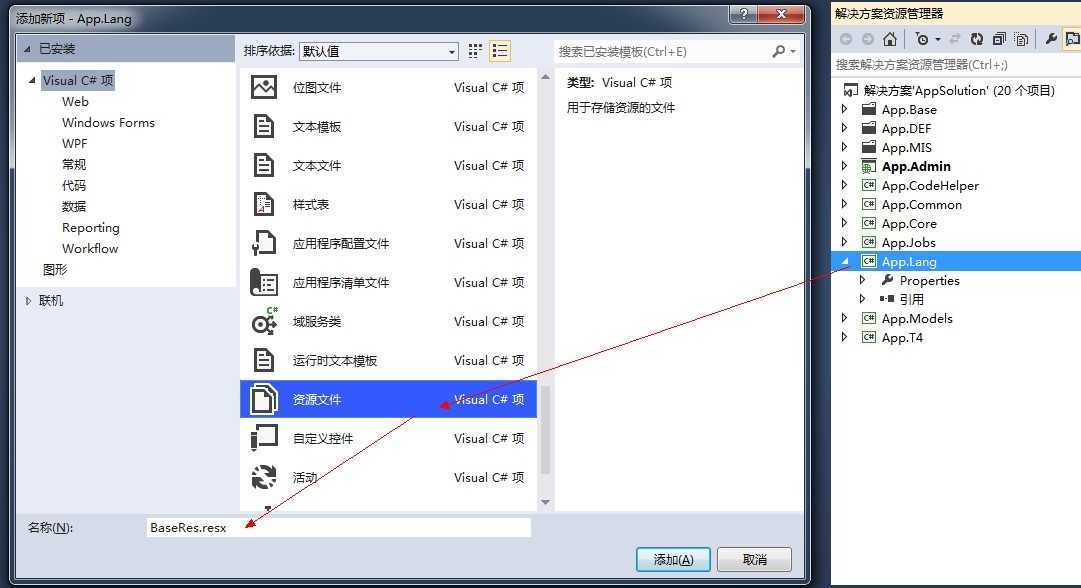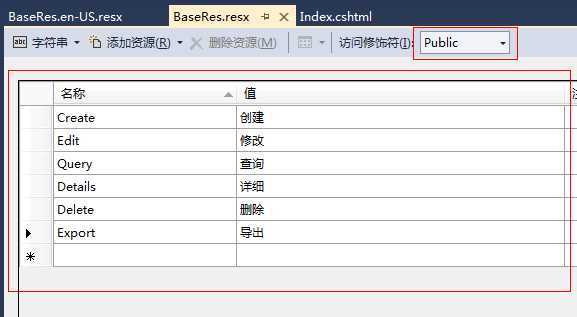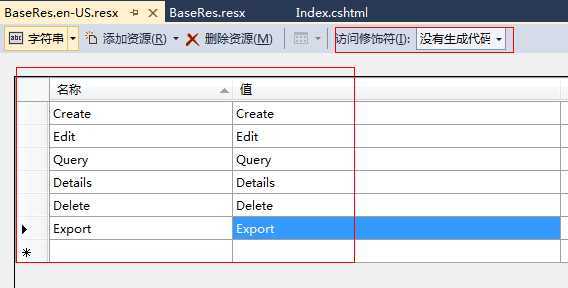构建ASP.NET MVC4+EF5+EasyUI+Unity2.x注入的后台管理系统(30)-本地化(多语言)
2020-12-13 05:55
标签:style blog class c code java
我们的系统有时要扩展到其他国家,或者地区,需要更多的语言环境,微软提供了一些解决方案,原始我们是用js来控制的,现在不需要了。 我们只要创建简单的资源文件,通过MVC的路由设置就可以轻松的进行语言中的切换。 本节受益于:Asp.net MVC3
高级编程第121页。大家可以自行百度这本书,这应该是国内第一本中文版的MVC3.0教程 现在从项目入手吧(本节也适合其他MVC程序),新建一个语言项目来放资源文件。 一、新建App.Lang,同时新建BaseRes.resx和BaseRes.en.resx或者其他国语言 分别是中文,英文。并引用System.Web类库i 二、处理通讯,配置App.Admin
web.config,让这个类生效 在App.Admin中的Core文件夹添加CultureAwareHttpModule文件并继承IHttpModule 这里必须做个声明:下面2段第一段支持MVC3,第二段支持MVC4 -----------------------MVC3.0 -----------------------MVC4.0 (VS2012 版本配置以下, VS2010的MVC4版本配置同MVC3.0) 红色部分在system.web节点内,type包含的是命名空间 三、注册路由 打开RouteConfig.cs,注册为 路由执行有先后大家都懂的。可以看出最后我们的访问会是这样的 http://localhost:1201/(http://localhost:1201/zh),http://localhost:1201/等 四、将要本地化的项目引用App.Lang 回到Resx文件,打开Resx设置代码为的访问修饰符为public,并添加如下属性,可以看出是键值对应 这里我们以SysSample的index视图为例,回到index上修改如下代码 先引入@using App.Lang;然后修改以下代码 其中的BaseRes.Query就是国际化属性了 预览一下例子(请注意我的URL地址变化) 现在你可以本地化您的项目了。最后一个声明,如果你要获取当然选中的是什么语言你必须在页面引用 CultureInfo info =
Thread.CurrentThread.CurrentCulture; 通过info.Name可以获取到URL上选择的zh或en 例: 结果 构建ASP.NET
MVC4+EF5+EasyUI+Unity2.x注入的后台管理系统(30)-本地化(多语言),搜素材,soscw.com 构建ASP.NET
MVC4+EF5+EasyUI+Unity2.x注入的后台管理系统(30)-本地化(多语言) 标签:style blog class c code java 原文地址:http://www.cnblogs.com/lonelyxmas/p/3738880.html


using System;
using System.Collections.Generic;
using System.Globalization;
using System.Linq;
using System.Text;
using System.Threading;
using System.Threading.Tasks;
using System.Web;
using System.Web.Routing;
namespace App.Admin
{
public class CultureAwareHttpModule : IHttpModule
{
private CultureInfo currentCulture;
private CultureInfo currentUICulture;
public void Dispose() { }
public void Init(HttpApplication context)
{
context.BeginRequest += SetCurrentCulture;
context.EndRequest += RecoverCulture;
}
private void SetCurrentCulture(object sender, EventArgs args)
{
currentCulture = Thread.CurrentThread.CurrentCulture;
currentUICulture = Thread.CurrentThread.CurrentUICulture;
HttpContextBase contextWrapper = new HttpContextWrapper(HttpContext.Current);
RouteData routeData = RouteTable.Routes.GetRouteData(contextWrapper);
if (routeData == null)
{
return;
}
object culture;
if (routeData.Values.TryGetValue("lang", out culture))
{
try
{
Thread.CurrentThread.CurrentCulture = new CultureInfo(culture.ToString());
Thread.CurrentThread.CurrentUICulture = new CultureInfo(culture.ToString());
}
catch
{ }
}
}
private void RecoverCulture(object sender, EventArgs args)
{
Thread.CurrentThread.CurrentCulture = currentCulture;
Thread.CurrentThread.CurrentUICulture = currentUICulture;
}
}
}

public static void RegisterRoutes(RouteCollection routes)
{
routes.IgnoreRoute("{resource}.axd/{*pathInfo}");
routes.MapRoute(
"Globalization", // 路由名称
"{lang}/{controller}/{action}/{id}", // 带有参数的 URL
new { lang = "zh", controller = "Home", action = "Index", id = UrlParameter.Optional }, // 参数默认值
new { lang = "^[a-zA-Z]{2}(-[a-zA-Z]{2})?$" } //参数约束
);
routes.MapRoute(
"Default", // 路由名称
"{controller}/{action}/{id}", // 带有参数的 URL
new { controller = "Home", action = "Index", id = UrlParameter.Optional } // 参数默认值
);
}








src=‘/@info.Name/SysSample/Create‘
src=‘/en/SysSample/Create‘
文章标题:构建ASP.NET MVC4+EF5+EasyUI+Unity2.x注入的后台管理系统(30)-本地化(多语言)
文章链接:http://soscw.com/essay/32001.html